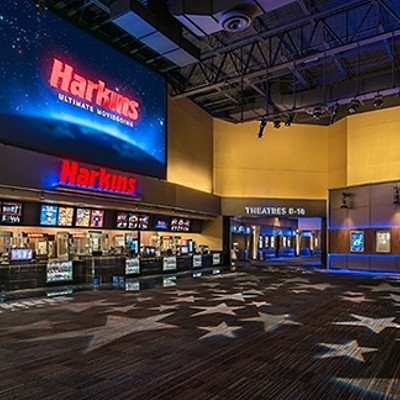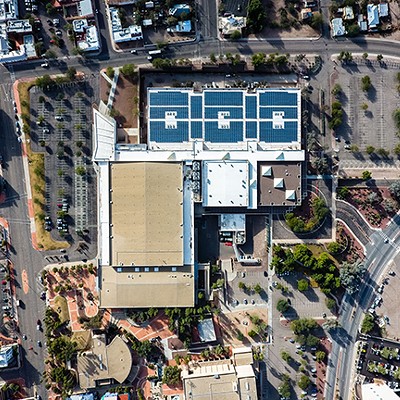Architect Corky Poster thinks so. Hired to prepare a master plan for the area, he has come up with eight recommendations, including upgrading the physical condition of the historic warehouses and developing a lushly landscaped 25-foot wide urban artwalk along Stone and Toole avenues, where art would flow out of the adjacent buildings. Also on the list are construction of a performance amphitheater near the Stone Avenue underpass and building artist live-work space apartments on existing parking lots.
Where funding for these projects would come from, though, has not been addressed. "This is a smart town," Poster says. "People will figure out how to pay for them." His final report instead will be "thin" and based on a non-prioritized action plan.
Despite the financial uncertainty of implementation, the results of the planning process so far are "heavenly," according to artist Steven Eye. The mask-maker has occupied a warehouse in the district for 17 years.
"Poster has great vision, and I totally support what he is doing," Eye says.
When asked how the recommended improvements for the district might be paid for, Eye responds, "The city of Tucson should realize the value of the area. They would reap tremendous dividends by having some creative vision. By finding funding sources, they would get back way more (than they would invest)."
Another unmentioned possibility to pay for the plan's recommendations is through increased rents from the now-affordably-priced, government-owned warehouses. When this idea was floated last year, however, it received a chilly reception from artists (See "Blank Walls," June 5, 2003).
Funding options for improvements aren't the only outstanding issue facing the warehouse district. Another is who will oversee implementation of the plan's suggestions.
Poster thinks an "artist/tenant-centered" management organization should fill this role. The group would be charged with selecting warehouse occupants using pre-established criteria while also setting a sliding-scale rent structure. Daily management of the district would additionally be under its purview, along with the responsibility for implementing the recommended capital improvements.
To accomplish these goals, Poster has offered three options: One would be an advisory committee reporting to the Tucson City Council; another is having the existing Tucson Arts District Partnership perform this function. The third possibility is creating a new nonprofit group.
Vera Uyehara, executive director of the partnership, strongly supports her agency being selected. Pointing out they have coordinated arts activities downtown for almost 15 years and have a track record of accomplishments, Uyehara proposes establishing an independent committee of artists under the Partnership umbrella which would manage the warehouse district.
"They could be a conduit to the real estate and artist expertise" required to oversee district development, she says, adding that she believes the group should be advisory to the city, since it is the government that owns many of the warehouses.
Ceramic sculptor and longtime warehouse district property manager David Aguirre takes a different perspective. He would like a new board created, comprised of artists and other district stakeholders, that would have final decision-making responsibilities.
Tentatively naming this group WAMO, for Warehouse Arts Management Organization, Aguirre says his approach insures current artists and tenants in the district are listened to by city officials.
To settle this dispute, Poster is recommending a facilitated mediation process be conducted after the plan is completed late next month. "There are strong passions in the district," he says, "and hopefully (the issue) won't blow up."
As the warehouse district potentially becomes more physically attractive, some type of rental restrictions may be necessary to prevent the displacement of long-time, low-income artists. As one was overheard grumbling at the last planning meeting, "Those (proposed) apartments they're showing are something I couldn't afford."
Steven Eye adds, "Our fear was that once the (existing) buildings were fixed up, the city would dump us out of here." But he now believes the plan Poster is working on "puts power in our hands."
While he and many others are generally optimistic about the warehouse district's future, the legal pitfalls of possible rental regulations and other controls over government-owned buildings has yet to be confronted. Under the law, will a warehouse district management organization of any type be able to define who is an artist, or offer a lower rental rate for one tenant but insist on greater amounts from another?
While these controversial questions await an answer, Eye concludes enthusiastically, "I love what Poster is doing."












